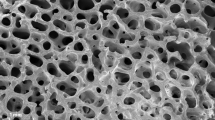Abstract
Purpose
Recently, several authors have proposed techniques for improving the fusion rate in pediatric posterior occipitocervical fusion including a variety of implants and the use of bone morphogenetic protein. A technique by Koop et al. using a periosteal flap for occipitocervical arthrodesis was described in 1984.
Methods
A straight incision is made about the posterior neck to expose the occipitocervical region from the inion superiorly to the lowest cervical vertebrae to be fused inferiorly. The occiput is exposed superficial to the periosteum, which is then reflected and elevated from the occiput. The attachment is preserved at the caudal base of the flap and reflected over the intended area of fusion. When possible, fixation is then performed with cables, wires, screws, hooks, or plates.
Case example
A 6-year-old male with an occiput to C2 distraction injury underwent posterior spinal fusion from occiput to C3 using sublaminar wires, periosteal turndown flap, and autologous iliac crest bone graft.
Conclusion
In small children with traumatic upper cervical spine instability, the periosteal turndown technique may be used as a safe adjunct for occipitocervical fusions.






Similar content being viewed by others
References
Dormans JP, Drummond DS, Sutton LN et al (1995) Occipitocervical arthrodesis in children: a new technique and analysis of results. J Bone Jt Surg Am 77:1234–1240
Schultz KD Jr, Petronio J, Haid RW et al (2000) Pediatric occipitocervical arthrodesis: a review of current options and early evaluation of rigid internal fixation techniques. Pediatr Neurosurg 33:169–181
Cohen MW, Drummond DS, Flynn JM et al (2001) A technique of occipitocervical arthrodesis in children using autologous rib grafts. Spine 26:825–829
Hwang SW, Gressot LV, Rangel-Castilla L et al (2012) Outcomes of instrumented fusion in the pediatric cervical spine. J Neurosurg Spine 17:397–409
Anderson RC, Ragel BT, Mocco J et al (2007) Selection of a rigid internal fixation construct for stabilization at the craniovertebral junction in pediatric patients. J Neurosurg 107:36–42
Lindley TE, Dahdaleh NS, Menezes AH et al (2011) Complications associated with recombinant human bone morphogenetic protein use in pediatric craniocervical arthrodesis. J Neurosurg Pediatr 7:468–474
Koop SE, Winter RB, Lonstein JE (1984) The surgical treatment of instability of the upper part of the cervical spine in children and adolescents. J Bone Jt Surg Am 66:403–411
Huang M, Gonda DD, Briceno V, Lam SK, Luerssen TG, Jea A (2015) Dyspnea and dysphagia from upper airway obstruction after occipitocervical fusion in the pediatric age group. Neurosurg Focus 4:E10
Izeki M, Neo M, Ito H, Nagai K, Ishizaki T, Okamoto T, Fujibayahi S, Takemoto M, Yoshitomi H, Aoyama T, Matsuda S (2013) Reduction of atlantoaxial subluxation causes airway stenosis. Spine 9:E513–E520
Miyata M, Neo M, Fujibayashi S, Ito H, Takemoto M, Nakamura T (2009) O-C2 Angle as a predictor of dyspnea and/or dysphagia after occipitocervical fusion. Spine 2:184–188
Tian W, Yu J (2013) The role of C2–C7 and O-C2 angle in the development of dysphagia after cervical spine surgery. Dysphagia 2:131–138
Acknowledgements
All figures and tables in this manuscript are used with permission of the Children’s Orthopaedic Center, Los Angeles.
Author information
Authors and Affiliations
Corresponding author
Ethics declarations
Conflict of interest
DLS (reports personal fees from ZimmerBiomet, Grand Rounds, Medtronic, Orthobullets, Zipline Medical Inc., Green Sun Medical, Biomet Spine, Johnson & Johnson, and Wolters Kluwer Health-Lippincott Williams & Wilkins; nonfinancial support from Growing Spine Foundation, Growing Spine Study Group, Scoliosis Research Society, Orthobullets; other from Zipline Medical Inc.; research grants from Pediatric Orthopaedic Society of North America, Scoliosis Research Society (Paid to Columbia University), Ellipse (Co-PI, Paid to Growing Spine Foundation), outside the submitted work).
LMA (reports personal fees from Biomet, Medtronic, and Orthobullets; other from Eli Lilly; nonfinancial support from Pediatric Orthopaedic Society of North America and Scoliosis Research Society, Journal of Pediatric Orthopedics, outside the submitted work).
Ethical approval
This study has been carried out with approval from the Committee on Clinical Investigations at Children’s Hospital Los Angeles.
Funding
None of the authors received financial support for this study.
Rights and permissions
About this article
Cite this article
Yasmeh, S., Quinn, A., Harris, L. et al. Periosteal turndown flap for posterior occipitocervical fusion: a technique review. Eur Spine J 26, 2303–2307 (2017). https://doi.org/10.1007/s00586-017-5085-8
Received:
Revised:
Accepted:
Published:
Issue Date:
DOI: https://doi.org/10.1007/s00586-017-5085-8




